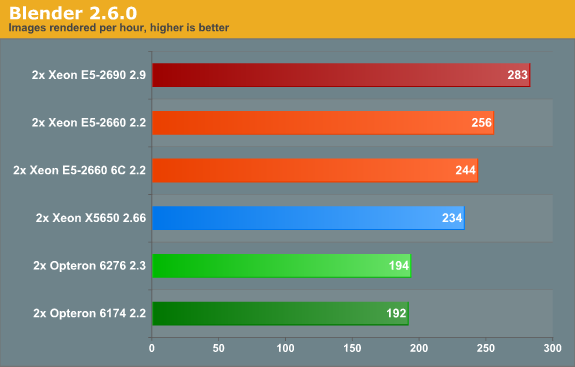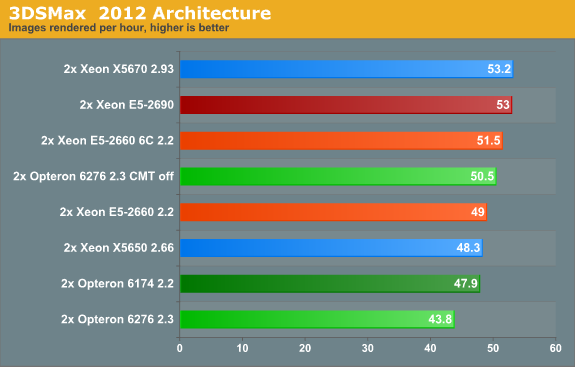The Xeon E5-2600: Dual Sandy Bridge for Servers
by Johan De Gelas on March 6, 2012 9:27 AM EST- Posted in
- IT Computing
- Virtualization
- Xeon
- Opteron
- Cloud Computing
Rendering: Blender 2.6.0
Blender is a very popular open source renderer with a large and active community. We tested the 64-bit Windows edition, using version 2.6.0a. If you like, you can perform this benchmark very easily too. We used the metallic robot, a scene with rather complex lighting (reflections) and raytracing. Furthermore to make the benchmark more repetitive, we changed the following parameters:
- The resolution was set to 2560x1600
- Antialiasing was set to 16
- We disabled compositing in post processing
- Tiles were set to 16x16 (X=16, Y=16)
- Threads was set to auto (one thread per CPU is set).
As we have explained, the current 24 and 32 core CPUs benefit from using a much larger number of tiles than we have previously used (64, 8x8). That is why we raised the number of tiles to 256 (16x16), though all CPUs perform better at this setting.
To make the results easier to read, we again converted the reported render time into images rendered per hour, so higher is better.

Blender is Xeon territory for sure, as Blender mostly runs in the L1 and L2 cache. Therefore a E5-2630 (2.3 GHz, 15 MB L3, $612) will probably perform about 4% faster than the six-core Xeon E5-2660 in this test. Our six-core Xeon E5-2660 is about 26% faster than the best Opteron. We estimate that the Xeon E5-2630 will offer more or less the same performance at an almost 30% lower pricepoint than the Opteron 6276. Whether you have a lot or little to spend, the Xeon E5 is your best bet for Blender.
Rendering Performance: 3DSMax 2012
As requested, we're reintroducing our 3DS Max benchmark. We used the "architecture" scene which is included in the SPEC APC 3DS Max test. As the Scanline renderer is limited to 16 threads, we're using the iray render engine, which is basically an self-configuring Mental Ray render engine.

We rendered at 720p (1280x720) resolution. We measured the time it takes to render 10 frames (from 20 to 29) with SSE enabled. We recorded the time and then calculated (3600 seconds * 10 frames / time recorded) how many frames a certain CPU configuration could render in one hour. All results are reported as rendered images per hour; higher is thus better. We used the 64-bit version of 3ds Max 2008 on 64-bit Windows 2008 R2 SP1.

Even with the advanced iray renderer, 3DS Max rendering reaches our scaling limits. The 32-thread Xeons do not come close to 100% CPU load (more like 90%) and in between the frames there are small periods of single threaded processing. Amdahl's law is most likely reason here. We suspect that highly clocked lower core count models can pass the 53 fps barrier we're seeing here.










81 Comments
View All Comments
MrSpadge - Tuesday, March 6, 2012 - link
Put some sarcasm tags in there to save some people from getting confused...cynic783 - Tuesday, March 6, 2012 - link
definitely sarcastic. i was actually surprised not to see any fanbois so I thought I'd pretendbadjohny - Tuesday, March 6, 2012 - link
I have no doubt these chips or something similar will end up in the new mac pros. Who are in a very bad need of a refresh.Shuxclams - Tuesday, March 6, 2012 - link
Looking at a complete visualization transformation in our server room, looks like the decision was made for us as far as architecture. Wow....TeXWiller - Tuesday, March 6, 2012 - link
<quote>The new Xeon also supports faster DDR-3 1600. Contrary to the Interlagos Opteron which can only support this memory speed with one DIMM per channel</quote>Interlagos supports memory up to DDR3-1600 using two single rank memory modules, or one single rank and one double rank module if using registered memory, and two single rank modules if using unbuffered memory. DDR3-1866 is supported on a single load-reduced registered, or on a single unbuffered module per channel. It depends on the board manufacturer and more importantly, it can be all read on the manual, so to speak.davegraham - Tuesday, March 6, 2012 - link
AMD Interlagos can support more than 1 DDR3-1600 ECC/REG dimm per channel. I run 8 on a single socket 6276 and it works at the rated speed.TeXWiller - Wednesday, March 7, 2012 - link
Too bad these kinds of errors in the articles are not usually fixed.JohanAnandtech - Wednesday, March 7, 2012 - link
I will double check .meloz - Tuesday, March 6, 2012 - link
Just wanted to congratulate Johan on a job well done. Very thorough analysis, Intel have achieved a very dominant position with this new platform and this is reflected in pricing of their processors as well!AMD was already a sub 10% niche (with a market share to mirror) in the data center, now even that niche has evaporated.
New Opterons (based on Piledriver) might decrease the performance gap to Intel under certain benchmarks, but I doubt they will beat Intel. Intel has plenty of SKUs above the quickest AMD Opterons to adjust prices and kill any new challenge from AMD, instantly.
JohanAnandtech - Wednesday, March 7, 2012 - link
Thanks! Although I hope Intel gets a bit more competition though.